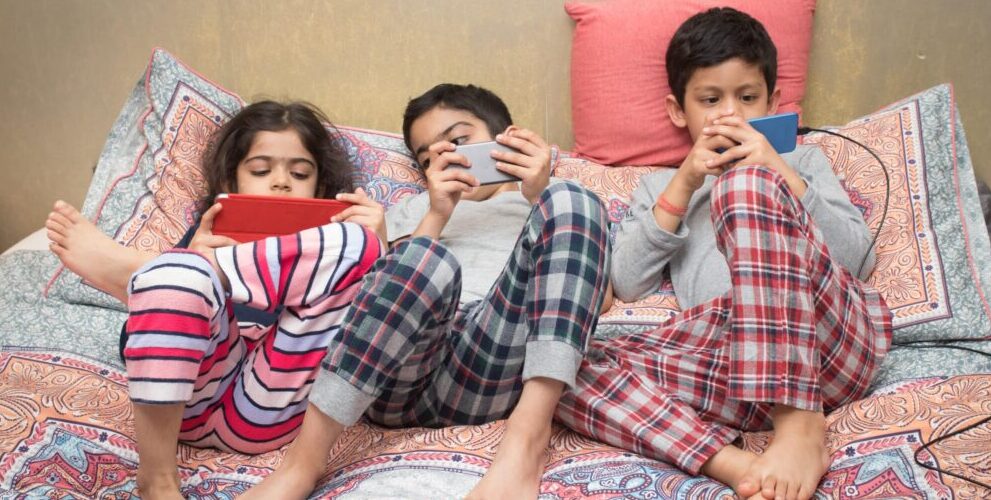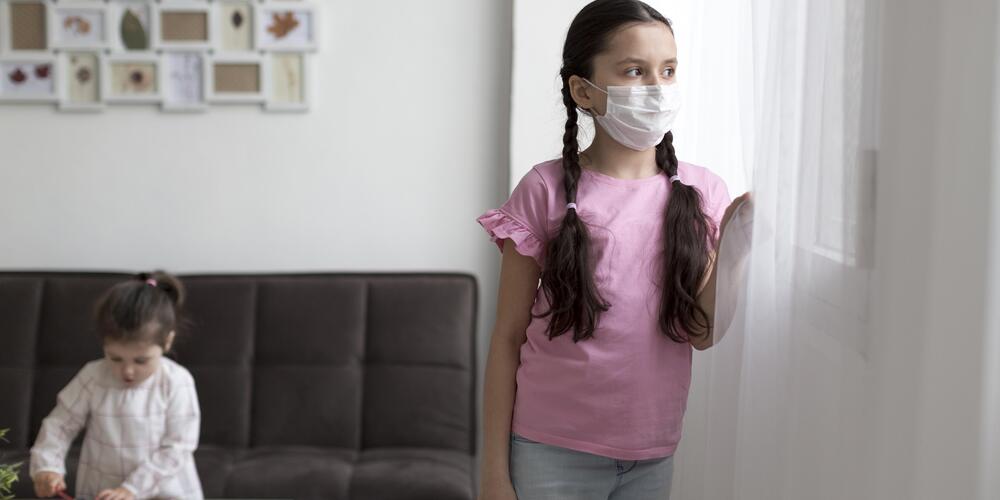Are cartoons hurting your child? Find out how excessive screen time impacts children’s brains, behaviour, and long-term health
Far from being a harmless pastime, excessive screen use was linked to delayed language development, reduced cognitive skills, poor social behaviour, sleep disturbances, higher obesity risk, and difficulty concentrating
Author
Author
- admin / 3 weeks

- 0
- 12 min read

Author
For Sarah Raza, a working mother with a two-and-a-half-year-old son, managing he child’s screen time has become a daily negotiation. Her child started watching Cocomelon a year ago. “It’s weird,” Sarah admits, “whenever a new rhyme comes up, even I sit and watch. The storytelling is really good sometimes.”
Currently, her son averages about an hour of screen time a day, broken into short intervals rather than a single sitting. To manage his exposure, Sarah makes sure he watches mostly on the TV—restricting phone or tablet use—and closely supervises his YouTube use. “There’s an option to restrict content,” she explains. “If he watches animal videos, only similar content comes up. I don’t want him exposed to a wide, unfiltered pool of content that isn’t good for him.”
She also balances this with plenty of outdoor activities. Her son goes to the clubhouse, plays in the park, and cycles regularly, so screen time doesn’t entirely replace active play. Still, Sarah admits the pull of bright visuals and catchy music is hard to resist: “These shows are so bright and with such catchy music, it really attracts him, and he gets zoned out.”
That influence often spills into daily life too—so much so that her son has started calling every dog in the colony “Bingo,” she laughs, referring to the popular rhyme where a dog is named Bingo.
Sarah’s story reflects the everyday struggles of parents everywhere. When the Australian show Bluey gained popularity in the US, parents shared online that they noticed their kids asking for “brekky,” looking for the “rubbish bin,” or calling their mothers “Mum.” On Reddit, American parents humorously exchanged stories: a child from Alabama saying “sorry” with an Aussie twang, another calling tomatoes “to-mah-toes,” and yet another picking up British phrasing from Peppa Pig.
While some laugh it off, on the other side, if you scroll through Instagram or parenting groups, you’ll also find reels of mothers and fathers proudly sharing their ‘less screen time rule,’ offering tips and small victories in the ongoing tug-of-war between technology and healthy growth.
Parents today are constantly juggling hectic schedules while trying to learn, unlearn, and figure out the best ways to safeguard their children’s well-being. And at the centre of it all are cartoons—the bright, fast-paced shows that children can’t seem to get enough of. From the endlessly looping rhymes of Cocomelon to the addictive tunes of Baby Shark doo-doo-doo-doo-doo-doo, these programs echo through households, often keeping kids glued to screens during meals or playtime. What may look like harmless entertainment, however, carries hidden risks for children’s health. Cartoons have always been part of childhood, but what has changed is access—today, screens are omnipresent, whether in the form of cartoons, YouTube channels, or educational apps.
According to the American Academy of Child and Adolescent Psychiatry, there are specific screen time guidelines. Until 18 months of age, screen use should be restricted to video chatting with an adult, such as a travelling parent. Between 18 and 24 months, children may watch educational programming—but only with a caregiver. For ages 2–5, non-educational screen time should be limited to about one hour on weekdays and three hours on weekends. For children aged six and older, healthy digital habits should be encouraged, and screen use should be monitored.
The guidelines also emphasise family practices such as turning off devices during meals, removing screens before bedtime, and avoiding their use as pacifiers or tantrum-stoppers.
Yet, despite these recommendations, parents often face a dilemma. Many children refuse to eat without watching a cartoon; others are pacified only when given a screen. For working mothers and busy parents, cartoons and screens become necessary babysitters, offering precious minutes to cook dinner, catch their breath, or simply rest.
In fact, a recent meta-analysis by researchers at AIIMS-Raipur found that children under the age of five in India spend an average of 2.22 hours every day in front of screens — that’s twice the safe limit set by experts like the WHO and the Indian Academy of Pediatrics (IAP). Even more worrying is the screen exposure among babies — children under 2 years were spending an average of 1.23 hours daily on screens, despite WHO and IAP guidelines recommending zero screen time for this age group. Far from being a harmless pastime, excessive screen use was linked to delayed language development, reduced cognitive skills, poor social behaviour, sleep disturbances, higher obesity risk, and difficulty concentrating.
What are the hidden triggers in children’s cartoons?
At first glance, children’s programming appears harmless—songs, nursery rhymes, and animated characters meant to entertain. However, researchers warn that beyond overtly inappropriate content such as violence or crude humour, there are subtle, less obvious characteristics that may negatively affect children’s development. Two such covert traits have been flagged repeatedly by childhood development experts: pace and stimulation.
Fast-paced children’s shows, like the animated brightly coloured ones one often finds online, use quick scene changes, high-energy music, and rapid storytelling to capture children’s attention. While engaging in the short term, this relentless pace has been found to impact executive functioning—the mental skills involved in problem-solving, planning, and self-control.
A study involving 60 four-year-olds randomly assigned children to watch a fast-paced television cartoon, an educational cartoon, or draw for nine minutes. Those exposed to the fast-paced cartoon performed significantly worse on executive function tasks—including the delay-of-gratification and Tower of Hanoi tasks—compared to the other groups.
The researchers concluded that “Just nine minutes of viewing a fast-paced television cartoon had immediate negative effects on 4-year-olds’ executive function. Parents should be aware that fast-paced television shows could at least temporarily impair young children’s executive function.”
Overstimulation is another major concern in children’s programming. Many shows use flashing visuals, bright colours, loud sounds, and repetitive music to capture and hold young viewers’ attention. “It is medically an addiction. Every time children view screens, hormones like dopamine, serotonin, oxytocin, and tryptophan—our reward and pleasure hormones—are released, reinforcing the behaviour and making it more addictive over time,” explained Prof. Dr Sanjeev Bagai, Padma Shri, Senior Consultant Paediatrician & Nephrologist and Chairman of Nephron Clinics.
Even other shows, which may seem less fast-paced, may be encouraging bad behaviour, reinforcing archaic gender roles, and overstimulating because of its music and bright colours.
“Children tend to mimic and act out fictitious characters, idealising cartoon behaviours, which further affects their emotional and social development. Exposure to unfiltered or inappropriate content, including sexual material, can be harmful to a young, developing brain,” according to Dr Bagai.
How screen time affects children
Research increasingly highlights the complex ways in which screen time influences children’s cognitive, social, and emotional development—even “virtual autism.” In 2018, a Romanian psychologist, Marius Zamfir first used the term “to describe behavioral (sic.) abnormalities seen in children between zero and three years old, arising from sensory-motor and socio-affective deprivation caused by exposure to more than four hours/day of virtual environment.” According to Zamfir, many of the symptoms seen in kids who had greater exposure to screens were similar to those seen in kids on the autistic spectrum. However, unlike the autism spectrum disorder, this is environmental and reversible, with symptoms easing once you reduce screen time.
This concern was echoed by Dr Bagai, who highlighted the profound effects of excessive screen time and social media exposure on children. “Excessive exposure predisposes children toward autism spectrum disorder. The rapid colour changes, close viewing distances, and improper postures can harm eyesight, coordination, and spinal health, leading to cervical problems, nystagmus, and other ophthalmological issues, which in turn affect memory, attention, and cognitive function,” he said.
“There are large multi-centric trial studies, published in The Lancet, New England Journal of Medicine, and by the American Medical Association, which show that prolonged screen time—more than 30 to 40 minutes a day, especially at night or pre-bedtime—definitely affects children’s sleep patterns and can cause insomnia, restlessness, and aggression,” he explained.
He noted that such exposure could reduce cognitive abilities by upto 29 per cent, impacting speech fluency, memory, attention span, and behaviour. “If this pattern continues, it can even lead to mental illness in children. The risk increases with more frequent exposure: three days a week versus four or five days,” he said.
These are supported by studies too. A 2023 study published in the JAMA Network examined children aged one year and found that greater screen exposure was associated with developmental delays in communication and problem-solving at ages two and four. This study emphasises that even early exposure to screens can have measurable, long-term effects on critical developmental milestones.
Beyond developmental delays, prolonged exposure to highly stimulating shows can negatively impact attention span and creative play, which in turn can hinder cognitive growth. Excessive screen media usage has been shown to affect executive functioning, sensorimotor development, and academic outcomes. Early screen exposure may also interfere with language development by reducing the quantity and quality of interactions between children and caregivers. Contextual factors—such as co-viewing and appropriateness of content—play a crucial role in determining the impact on language skills. Moreover, overstimulation from flashing visuals, bright colours, and repetitive sounds can overwhelm developing brains, contributing to hyperactivity, difficulty in emotional regulation, and challenges in transitioning between activities.
A 2023 review further explored the cognitive and academic impacts of screen media use. The Quebec Longitudinal Study of Child Development found “a long-lasting connection between early screen media exposure and cognitive abilities, with each one-hour increase in TV exposure at two years of age corresponding to a 7 per cent unit decrease in participation in class and a 6 per cent unit decrease in math proficiency in the fourth grade.” (sic.)
Similarly, studies in Spain and the United States reported that higher screen time and media multitasking were linked to poorer academic performance and executive function outcomes. Language development was particularly affected, with fewer opportunities for practice leading to lower vocabulary acquisition and diminished expressive and phonological skills.
Another 2022 research conducted on 200 preschool children in Calicut assessed the relationship between cartoon viewing habits and attention span, social maturity, and developmental skills. Using multiple cognitive and behavioural assessments, the study found that “children who watched fewer cartoons have more social quotient (98 pc). Developmental skills are more in younger children (96 pc). Cartoon viewing habits have significant association with age, gender, birth order, number of siblings, and the class of study. Significant relationship between cartoon viewing habits and developmental skills.” (sic.) The researchers concluded that increased duration of cartoon viewing “can have a detrimental effect on the attention span and developmental skills of preschool children.”
Dr Bagai emphasised that younger children, especially those under five or ten, are particularly vulnerable as their early language learning can be disrupted, resulting in incoherent sentences, forgotten spellings, content of thought suffers, and diminished attention.
According to research published in Nature, titled ‘Screen habits and effects on sensory profiles in 6- to 36-month-old toddlers’, significant differences in sensory processing were observed based on screen exposure. Toddlers aged 6 to 18 months exhibited higher sensitivity and registration scores linked to greater direct screen exposure, while those aged 19 to 36 months showed higher sensory-seeking behaviours associated with both direct and background screen exposure.
The study concluded that “these behavioural patterns suggest that excessive screen exposure may impact sensory processing, reducing opportunities for active, multisensory interactions essential for development, emphasising the need for guidelines to manage screen use in early childhood to promote optimal sensory and cognitive development.”
What is worse is that many kids are exposed to not just cartoons and made for children content, but to short videos on social media that is meant for adult consumption. Dr Bagai pointed out the risks associated with violent, aggressive, or high-graphic content on social media and screens.
He elaborated on the long-term effects: “Excessive and inappropriate screen exposure can cause neuroinflammation, oxidative stress, mitochondrial damage, and dysfunction in the pituitary-hypothalamic axis, impairing neurons and reducing the formation of new neurons. It also accelerates brain aging, resulting in a loss of cognitive function equivalent to about two years, and increases the risk of obesity.”
What can we do to protect our children?
As the cause for such developmental delays is largely environmental, it is also reversible. By reducing your kids exposure to screen, the negative effects of it can be alleviated to a large extent.
“A large study conducted this year at Stanford involving 35,000 individuals showed that reducing screen time to negligible levels over six months led to a 22 pc improvement in mental and cognitive skills. This proves without doubt that limiting screen time can reverse some of its negative effects,” he added.
Dr Bagai also warned about the societal context, noting that with nuclear families and both parents working, children are increasingly exposed to screens, often influenced by parental device use. This is why it is essential to model appropriate behaviour for your children, by adopting screen free times and limiting our own screen times too. However, with many of us tethered to our devices most of the time, it is harder to enforce screen free times for children.
Referring to the famous 70s rock group Eagles’ hit song, Dr Bagai said, “We are all just prisoners here… of our own devices.”
Also Read: Two decades of service, yet ASHA workers’ demands remain unheard










